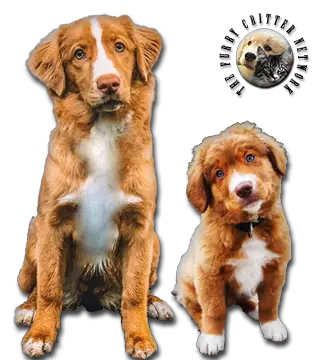Breed Standard
Head: Broad. Slightly domed skull. Pronounced stop. Brown nose.
Ears: Set on high, triangular.
Eyes: Almond-shaped, widely spaced, amber or brown.
Body: Strong. Deep chest.
Tail: Well-feathered.
Hair: Medium in length, somewhat wavy, slightly oily, waterproof. Undercoat. Feathering on the backs of the legs.
Coat: Rust with white markings on the chest, feet, tip of the tail, and sometimes the foreface.
Size: Dog: 49 to 55 cm. (19-21.5 in).Bitch: 43 to 49 cm. (17-19.5 in).
Weight: Approx. 25 kg (55 kg).
History
The breed was developed in the community of Little River Harbour in Yarmouth County, Nova Scotia, around the beginning of the 19th century to toll waterfowl. The breed was originally known as the Nova Scotia Duck Tolling Retriever or the Yarmouth Toller. Its exact origins are not known but it appears that some possibly spaniel and setter-type dogs, retriever-type dogs, and farm collie may have gone into the mix. It may share origins with the smaller Kooikerhondje, which has a similar method of work.
The Toller was officially admitted to the Canadian Kennel Club in 1945. Declared the provincial dog of Nova Scotia in 1955, the breed gained national recognition in 1980, when two Nova Scotia Duck Tolling Retrievers were awarded Best in Show at championship events that included many breeds. On June 11, 2001, it was approved for admission into the Miscellaneous Class of the American Kennel Club and was granted full recognition into the Sporting Group on July 1, 2003.
Behavior
Nova Scotia Duck Tolling Retrievers are known to be very intelligent, alert, high-energy dogs. They tend to be very affectionate and outgoing animals with family members and are known for being very patient with children. Some dogs may be reserved in new situations but shyness in adult dogs is considered a flaw.
Duck Tollers are working animals and are happiest when they have a job to do. Tollers are excellent hunting companions. Their keen sense of smell, intelligence, working drive, and small size, also make them perfect search and rescue dogs.
Physical stimulation should be provided for these dogs each day since they may become destructive when they are not exercised enough or left alone for too long. The breed standard states that the dog should have a strong retrieving drive, intense birdiness, endurance and a love for water.
Tollers do not have an aggressive bark. Some have a unique sounding bark known as the "Toller scream", a high-pitched, howl-like sound which is often referred to as their "singing". They do not use this in violent situations, however; for these they have a harsh growl. The Toller scream is used to express excitement.
He needs space and exercise for his well-being, as well as regular brushing and combing.
Function
The Toller is known to excel in various sporting and obedience activities, and health and safety related jobs. The breeds' high energy and intelligence makes them perfect candidates for difficult jobs that require tremendous dedication and skill. Tollers enjoy working and being outside, therefore, it is no surprise that they excel at various sport and job related activities.
The breed is categorized as a "sporting" dog under the CKC and AKA organizations making tollers ideal dogs for various physical activities. Other kennel clubs such as the AKNC and UKC categorize tollers as a "gundog" which depicts their drive, mental intelligence, and intuitive hunting sense. Kennel clubs throughout the world recognize Tollers as an athletic, intelligent, and a driven breed that has the innate ability to excel in any of the following activities: dog agility, dock jumping, disc catching, flyball, lure coursing, obedience, search and rescue, therapy dog, and hunting.
Health
This is a healthy working breed that is increasing in popularity. With its limited gene pool, a corresponding increase in some health dangers has occurred. Besides some thyroid and autoimmune problems, progressive retinal atrophy is starting to show up.






